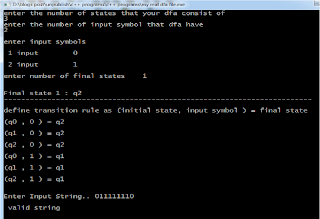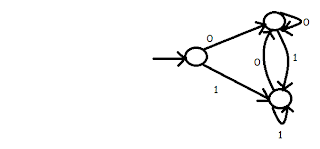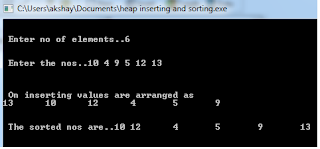C program of dfa implementation. Let us first know what is
DFA or let us again revise the concept of DFA? Automation are basically language acceptor or language
recognizer. A
finite automata is a collection of 5-tuple(Q,∑,∂,q0,F). Where
Q=finite set of states
∑=input symbol
∂=transition function
q0=initial state
F=set of final state
Here is the
c program to implement dfa
#include<stdio.h>
#include<conio.h>
int ninputs;
int check(char,int ); //function declaration
int dfa[10][10];
char c[10], string[10];
int main()
{
int nstates, nfinals;
int f[10];
int i,j,s=0,final=0;
printf("enter the number of states that your dfa consist of \n");
scanf("%d",&nstates);
printf("enter the number of input symbol that dfa have \n");
scanf("%d",&ninputs);
printf("\nenter input symbols\t");
for(i=0; i<ninputs; i++)
{
printf("\n\n %d input\t", i+1);
printf("%c",c[i]=getch());
}
printf("\n\nenter number of final states\t");
scanf("%d",&nfinals);
for(i=0;i<nfinals;i++)
{
printf("\n\nFinal state %d : q",i+1);
scanf("%d",&f[i]);
}
printf("-----------------------------------------------------------------------");
printf("\n\ndefine transition rule as (initial state, input symbol ) = final state\n");
for(i=0; i<ninputs; i++)
{
for(j=0; j<nstates; j++)
{
printf("\n(q%d , %c ) = q",j,c[i]);
scanf("%d",&dfa[i][j]);
}
}
do
{
i=0;
printf("\n\nEnter Input String.. ");
scanf("%s",string);
while(string[i]!='\0')
if((s=check(string[i++],s))<0)
break;
for(i=0 ;i<nfinals ;i++)
if(f[i] ==s )
final=1;
if(final==1)
printf("\n valid string");
else
printf("invalid string");
getch();
printf("\nDo you want to continue.? \n(y/n) ");
}
while(getch()=='y');
getch();
}
int check(char b,int d)
{
int j;
for(j=0; j<ninputs; j++)
if(b==c[j])
return(dfa[d][j]);
return -1;
}
output :
 |
c program to implement dfa
|
The above output is for the dfa to check whether the given binary number is even.
Its DFA is made as follows :
 |
| DFA: To check whether the given number is even |
and its table is made as :
States-Input | 0 | 1 |
q0 | q2 | q1 |
q1 | q2 | q1 |
q2 | q2 | q1 |
Uses of DFA: The very good example of finite state system is a control mechanism of elevator. It is very good tool for the programs such as text editors and lexical analyzer.
Thanks.
Read more...







